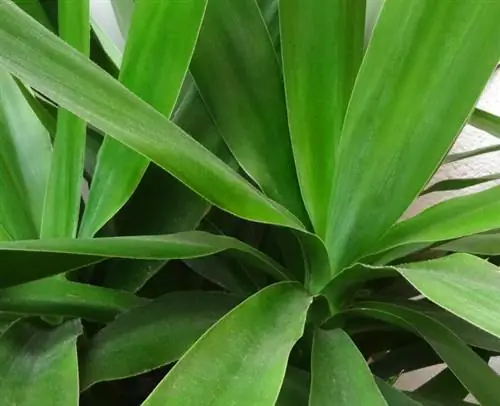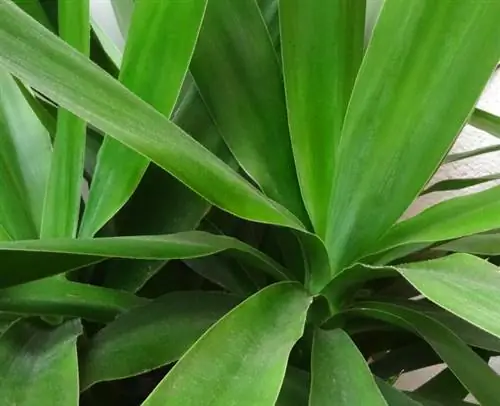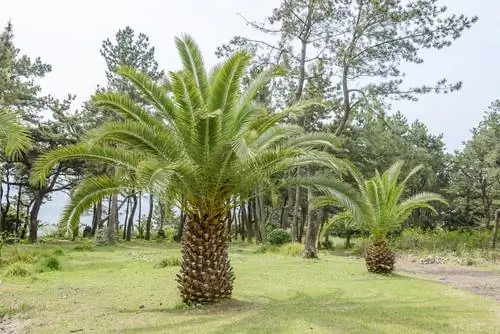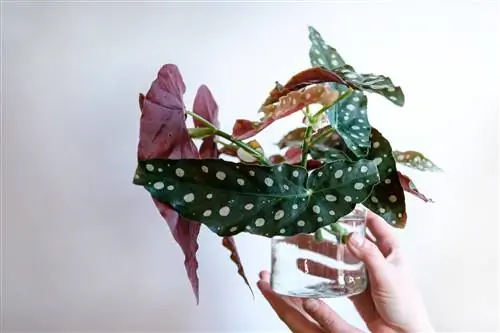- Author admin [email protected].
- Public 2023-12-16 16:46.
- Last modified 2025-01-23 11:21.
Yuccas or palm lilies are a genus of plants in the asparagus family. There are a whole range of different species, the two best known of which are probably the Yucca Filamentosa, also known as the garden yucca, and the Yucca elephantipes, which is primarily cultivated as a houseplant. Both species are considered to be quite easy to care for and can be propagated very easily.

How to propagate a yucca palm?
Yucca palms are easily propagated by taking cuttings or pieces of trunk and planting them in a mixture of potting soil and sand. Keep the substrate slightly moist and place the pots in a bright, warm location. Offshoots usually take root quickly and successfully.
Propagation of Yucca elephantipes by cutting
Yucca elephantipes is very propagative and reliably grows again from various plant parts that have been cut off. Whether you split the stem or take cuttings, they will most likely take root quickly. The easiest way to propagate is to divide a plant that has become too large, for example, by cutting the trunk into pieces. Even broken plants can often be saved in this way. The best time for rooting the individual plant pieces is spring or early summer - at this time the plant is particularly ready to grow. You can proceed as follows when propagating:
- The trunks of very tall yuccas can be divided several times.
- For example, you can divide the crest, the middle part of the trunk and the base of the trunk.
- The - usually leafless - stem base simply remains in the plant pot or is moved into fresh substrate.
- The head and middle part should also be placed in separate pots, preferably in a mixture of potting soil and sand.
- Place the pots in a bright and warm location
- and keep the substrate slightly moist.
- You should thin out heavily leafy cuttings as the plants lose too much water through evaporation
- and because the roots are still missing, we can't absorb anything fresh.
- In this case, it also helps to spray the parts to be rooted more frequently instead.
If the leaves become yellow and dry and/or parts of the trunk become soft, remove these parts and try rooting again.
Propagation of Yucca Filamentosa
The filamentous palm lily or garden yucca can also be propagated very easily. In particular, reproduction by division and planting offshoots is particularly promising. Some gardening enthusiasts were also able to propagate the plant by sowing seeds they had collected themselves.
Share garden yucca
Yucca Filamentosa can grow very wide, which is why dividing specimens that have become too large is a great idea. To do this, simply carefully dig up the plant using a digging fork and divide it into the desired number of plants. Be careful to damage the delicate roots as little as possible.
Getting and planting offshoots
Practically, the garden yucca produces numerous offshoots that simply need to be separated from the mother plant, dug up and planted separately.
Properly care for young garden yucca
Older garden yuccas are hardy down to minus 15 °C and can therefore easily be left outside in milder winters. However, young specimens and Yucca Filamentosa cultivated in pots should initially overwinter in a cool, but frost-free and bright place. The plants should be hardened off slowly so that after a few years they can finally be planted out in the garden.
Tip
Sometimes you have to be quite patient until the first shoots appear on the cut trunk of a Yucca elephantipes.






